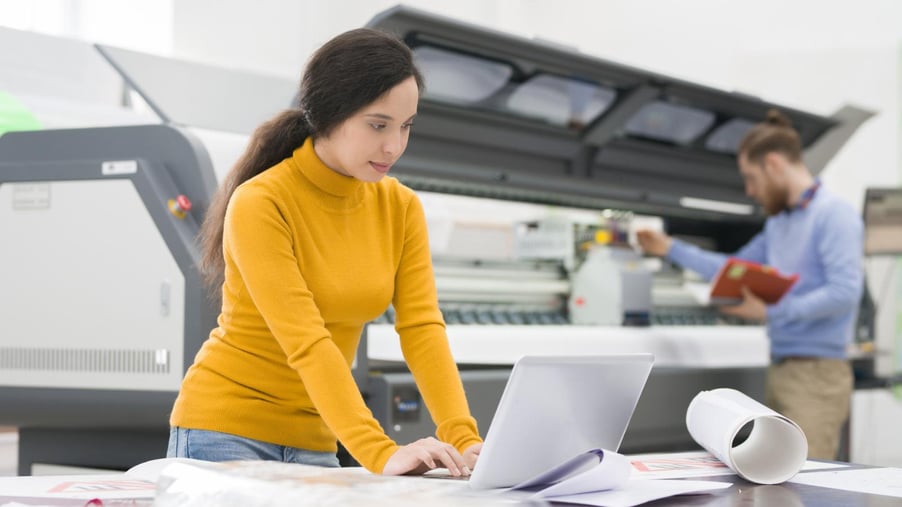I hope marketers will forgive me for saying so, but while marketing remains an important investment for any business, it isn’t exactly rocket science. However, savvy marketers do rely on a bit of neuroscience to help their clients stand out. A brand should speak volumes to its potential customers. And scientifically speaking, a picture is indeed worth a thousand words.
Our brains are designed to prioritize visual cues. In fact, over 50% of the surface of your brain is tasked with processing visual information. It’s a pretty complicated task, as it turns out, and one that we take for granted. But this is why it’s easier to teach computers to, say, play chess than it is to teach them to categorize and process images. Artificial intelligence could achieve checkmate in ten moves or less, but it still can’t beat simple captcha tests.
Rich, detailed images will always be some of the most powerful marketing tools. Large format printing puts that power right in your own hands.

1. What Is Large Format Printing?
Large format printing is printing that requires larger print materials, like architectural plans, posters, signage, and more. Printers that are capable of producing these materials are sometimes called wide-format printers or plotters. Additionally, large format printers can accommodate more materials than just paper; depending on the type of printer, you could print on metal, glass, wood, foam board, vinyl, plastic, canvas, and fabric.
2. How Does a Large Format Printer Work?
Once you’ve selected the materials you’d like to print on and the dimensions of your design, much like a traditional desktop inkjet printer, your large format printer will quickly apply ink to produce an image. However, unlike a traditional desktop printer, some large format printers also have a rapid drying process, often using UV lights to set the ink quickly.
3. What Are the Different Types of Large Format Printers?
Though large format printers come with various features and can use different types of ink, generally speaking, there are three basic categories: flatbed printers, roll-to-roll printers, and hybrid printers that combine both features. I’ll explain each of these in a little more detail.
Flatbed Printers
Flatbed printers print on flat or rigid materials. In short, a flatbed printer refers to a printer that has a 4’ x 8’ or 5’ x 10’ print bed, where rigid material is held in place by suction. Most flatbed printers can print on materials up 2–3” thick, including wood, plastics, glass, foamcore, sintra, gatorboard, and more.
Roll-to-Roll Printers
These printers can accommodate more flexible materials, like paper, vinyl, or fabric, and will churn out prints in a quick manner. Roll-to-roll printers are ideal for producing a great deal of material quickly.
Hybrid Printers
As the name would suggest, these printers will allow you to accommodate both rigid and flexible material. These hybrid printers provide dual printing capabilities and flexibility in one machine. This means less equipment, less equipment costs and less space needed.
4. What Will You Be Able To Create?
Large format printers greatly expand your ability to produce vibrant marketing materials. Common applications are listed below, but large format printers can also produce textiles and wallpaper.
- Banners
- Backdrops
- Trade Show Booth Materials
- Architectural & Engineering Design Construction Documents
- Maps
- Canvas Prints
- Retail Display Graphics
- Posters
- Wall Decals & Graphics
- Static Window Clings
- Vehicle Wraps
- Watercraft & Recreational Vehicle Wraps
- Point-of-Purchase and Point-of-Sale Graphics
- Floor Decals
5. Pro Tips for Great Results
Always select the highest resolution file possible when using a large format printer so your image stays crisp when enlarged. If you’re printing anything including text, look for a simpler font so that the words can be read easily from a distance. It’s often wise to choose darker, bolder colors for the background, and much lighter colors for text.
It’s also important when you’re designing or selecting images that you pay attention to your color mode. Both RGB (Red Green Blue) and CMYK (Cyan Magenta Yellow Black) are modes for mixing color, but CMYK is better for printed products, as RGB file sizes are significantly smaller.
6. Advantages of Large Format Printing
UV-cured inks are more durable and will allow your projects to last longer, even when exposed to the elements. If you own a professional print business, a large format printer could do far more than help you create high-quality advertising materials and boost name recognition. It could help you differentiate yourself from your competition by offering eye-catching products that other local printers can’t.
7. Finding the Right Large Format Printer
If you do a simple search online, you’ll find a dizzying array of large format printers listed as top picks. These lists can help narrow down your search somewhat, but it’s difficult to compare long lists of products if you aren’t sure what you really need, and what you really don’t. Marco’s print experts can provide a custom recommendation, and thanks to our strategic partnerships, we can also offer you highly competitive prices.

